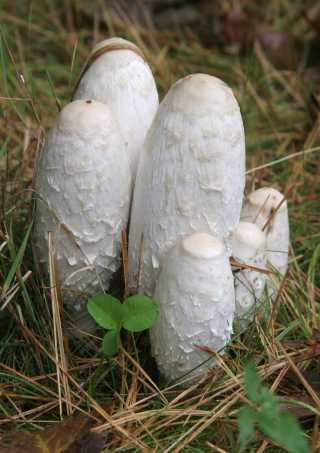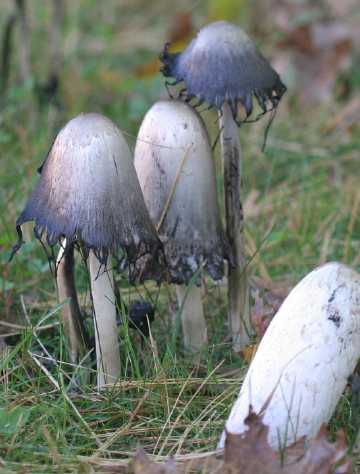

PHOTO COURTESY OF GARRY KESSLER
Shaggy mane mushrooms are long and slender when they first come up. The caps have scales that give them a shaggy look.
October 6, 2006, Page 4
NATURE NOTES
By ANNIE REID
Westborough Community Land Trust
From shaggy mane to inky cap
It's October again and mushroom season is here, filling Westborough's woods and clearings with colorful and odd-looking mushrooms and other fungi. Among them, the shaggy mane mushroom offers a sight fit for Halloween. <\p>
Shaggy mane (Coprinus comatus) mushrooms are long and slender, with ghostly white caps that often measure 2-5 inches long. As the name suggests, the caps have a shaggy look, due to the scales on them. <\p>
Long ago the shaggy caps earned these mushrooms another name – lawyer's wig. They reminded folks of the white powdered wigs worn by lawyers in courts of law in old England, where these mushrooms also grow. <\p>
When shaggy mane mushrooms start to come up, they look much like many other mushrooms that are just beginning to come up. In this "button" stage, many different kinds of mushrooms are difficult to tell apart. Even mushroom experts make mistakes at this stage. The buttons often look round, white, and smooth, with gills just forming. <\p>
Once they're up, shaggy manes get their distinctive shaggy look. You'll often find them in groups, with mushrooms at different stages. Like other mushrooms, they grow from the main part of the fungus, a spreading mass of threads that lives underground – or elsewhere, perhaps in a rotting tree trunk or stump, depending on what suits the particular fungus. The mushrooms that we see are the reproductive parts of the fungus. <\p>
The real Halloween creepiness begins once the shaggy mane mushrooms are up. Their large bullet-shaped caps don't fully open. Instead, they dissolve into black goo. You can often see the goo dripping from the rim of the cap. As time goes on, more and more of the cap dissolves, from the bottom up, until there's nothing left – except goo. <\p>

PHOTO COURTESY OF GARRY KESSLER
Shaggy manes dissolve into drippy black goo over time, as the mushroom caps slowly digest themselves. Shaggy manes and other self-digesting mushrooms are known as inky caps.
Because they turn into this inky black goo, shaggy manes are known inky caps, along with some other mushrooms that dissolve into inky black liquid. Shaggy manes are one of the larger and more noticeable examples of inky caps. <\p>
In earlier times – the days of quill pens – people actually used the black liquid from inky caps as ink. They got it by boiling the caps. <\p>
What's really going on when shaggy manes and other inky caps dissolve into an inky mess? The mushroom is actually digesting itself, thanks to an enzyme that its gills produce. Why does this happen? The whole process helps the mushroom to distribute its spores – which is what mushrooms exist to do. <\p>
Here's how it works. The spores mature in the shaggy mane's gills, beginning at the edge of the cap. As the spores fall away from the cap, the gills make the self-digesting enzyme, which conveniently gets rid of the old, empty parts of the gills. Now nothing blocks the exit route for the spores further up inside the cap. The self-digestion continues up the cap until the spores and the cap are gone. <\p>
This process doesn't make shaggy manes seem very appetizing, but surprisingly, they are considered edible by knowledgeable mushroom-hunters. The trick is apparently to pick them and cook them before they start to turn into goo, but after the button stage when they might be confused with other inedible or poisonous mushrooms. (Please remember that Nature Notes does not advise eating any wild mushroom or wild plant discussed in this column.) Not all inky cap mushrooms are edible. <\p>
Speaking of digestion, the fungus that puts up shaggy mane mushrooms has a carnivorous aspect. In the spirit of Halloween fun, you might even say that it eats worms. <\p>
So what does it do, really? Like other fungi, the underground thread-like portion of the shaggy mane fungus nourishes itself by releasing substances that digest dead matter in its surroundings. Then it absorbs the nutrients that become free. In this way, the fungus plays a role in nature's recycling. <\p>
But the shaggy mane fungus does more. It has very tiny "spiny balls" that stick like burrs to certain small roundworms in the soil. The spiny balls kill the roundworms, perhaps with a toxin. Then the fungus digests the worms. <\p>
You can find shaggy mane mushrooms in the woods, but their favorite haunts are where humans have disturbed the environment. Grassy lawns, hard-packed earth, and roadsides are places to look. Shaggy manes have been even known to push up through broken asphalt in parking lots as their cells swell with water. <\p>
In past years, shaggy manes have appeared behind Mill Pond School, along the edge of the grass near the woods, just in time for Halloween. <\p>
Perhaps shaggy mane mushrooms can inspire some new Halloween costumes this year. A trick-or-treater wearing a sheet doesn't have to be a ghost. Paint an uneven black border on the bottom of the sheet to look like the drippy black goo, or sew on a black fringe, and you've got a shaggy mane.
Date index
Month (October)
Common name index
Scientific name index
Category index